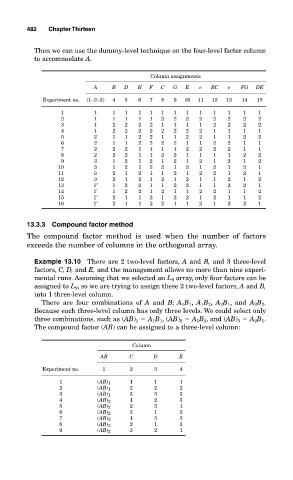Page 523 - Design for Six Sigma a Roadmap for Product Development
P. 523
482 Chapter Thirteen
Then we can use the dummy-level technique on the four-level factor column
to accommodate A.
Column assignments
A B D H F C G E e BC e FG DE
Experiment no. (1–2–3) 4 5 6 7 8 9 10 11 12 13 14 15
1 1 1 1 1 1 1 1 1 1 1 1 1 1
2 1 1 1 1 1 2 2 2 2 2 2 2 2
3 1 2 2 2 2 1 1 1 1 2 2 2 2
4 1 2 2 2 2 2 2 2 2 1 1 1 1
5 2 1 1 2 2 1 1 2 2 1 1 2 2
6 2 1 1 2 2 2 2 1 1 2 2 1 1
7 2 2 2 1 1 1 1 2 2 2 2 1 1
8 2 2 2 1 1 2 2 1 1 1 1 2 2
9 3 1 2 1 2 1 2 1 2 1 2 1 2
10 3 1 2 1 2 2 1 2 1 2 1 2 1
11 3 2 1 2 1 1 2 1 2 2 1 2 1
12 3 2 1 2 1 2 1 2 1 1 2 1 2
13 1′ 1 2 2 1 1 2 2 1 1 2 2 1
14 1′ 1 2 2 1 2 1 1 2 2 1 1 2
15 1′ 2 1 1 2 1 2 2 1 2 1 1 2
16 1′ 2 1 1 2 2 1 1 2 1 2 2 1
13.3.3 Compound factor method
The compound factor method is used when the number of factors
exceeds the number of columns in the orthogonal array.
Example 13.10 There are 2 two-level factors, A and B, and 3 three-level
factors, C, D, and E, and the management allows no more than nine experi-
mental runs. Assuming that we selected an L 9 array, only four factors can be
assigned to L 9 , so we are trying to assign these 2 two-level factors, A and B,
into 1 three-level column.
There are four combinations of A and B: A 1 B 1 , A 1 B 2 , A 2 B 1 , and A 2 B 2 .
Because each three-level column has only three levels. We could select only
three combinations, such as (AB) 1 A 1 B 1 ,(AB) 2 A 1 B 2 , and (AB) 3 A 2 B 1 .
The compound factor (AB) can be assigned to a three-level column:
Column
AB C D E
Experiment no. 1 2 3 4
1 (AB) 1 1 1 1
2 (AB) 1 2 2 2
3 (AB) 1 3 3 3
4 (AB) 2 1 2 3
5 (AB) 2 2 3 1
6 (AB) 2 3 1 2
7 (AB) 3 1 3 2
8 (AB) 3 2 1 3
9 (AB) 3 3 2 1

